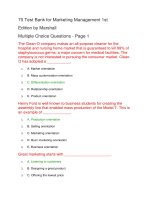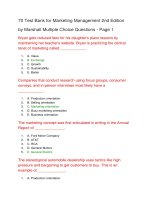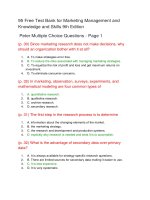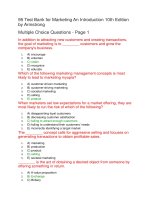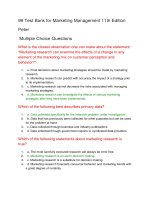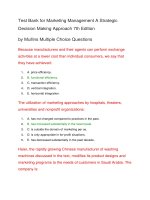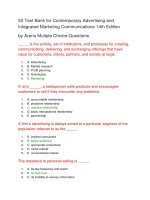95 test bank for marketing management and knowledge and skills 9th
Bạn đang xem bản rút gọn của tài liệu. Xem và tải ngay bản đầy đủ của tài liệu tại đây (138.02 KB, 24 trang )
95 Test Bank for Marketing Management and
Knowledge and Skills 9th
Edition Peter Multiple Choice Questions - Page 1
(p. 32) Data that has been previously collected for other purposes
but can be used for the problem at hand is known as
1.
A. research plan.
2.
B. proposal writing.
3.
C. secondary data.
4.
D. primary data.
(p. 30) Since marketing research does not make decisions, why
should an organization bother with it at all?
1.
A. To make strategies error free.
2.
B. To reduce the risks associated with managing marketing strategies.
3.
4.
C. To equalize the risk of profit and loss and get maximum returns on
investment.
D. To eliminate consumer concerns.
(p. 32) In marketing, observation, surveys, experiments, and
mathematical modeling are four common types of
1.
A. quantitative research.
2.
B. qualitative research.
3.
C. archive research.
4.
D. secondary research.
(p. 31) In the past, marketing researchers were primarily engaged
in the technical aspects of the research, but were not extensively
involved in
1.
A. sample selection of research findings.
2.
B. strategic use of research findings.
3.
C. research design.
4.
D. data collection.
(p. 32) Qualitative research typically involves
1.
A. face-to-face interviews.
2.
B. watching people and recording relevant facts.
3.
C. collection of data by means of a questionnaire.
4.
D. obtaining and analyzing numerical data.
(p. 32) All of the following are critical issues influencing the
research plan, except
1.
A. whether primary or secondary data are needed.
2.
B. whether qualitative or quantitative research is needed.
3.
4.
C. whether the company will conduct its own research or contract with a
marketing research specialist.
D. whether the research is totally error free and statistical in nature.
(p. 30-31) What is the closest observation one can make about
the statement: "Marketing research can examine the effects of a
change in any element of the marketing mix on customer
perception and behavior"?
1.
A. Marketing research does not make decisions.
2.
B. Marketing research can forecast with certainty what will happen in the
future.
3.
C. Marketing research can increase the risks associated with managing
marketing strategies.
4.
D. Marketing research can investigate effects of various marketing
strategies after they have been implemented.
(p. 32) Retail marketers are conducting research to estimate the
traffic flow during peak hours at various intersections. This is to
help determine the best locations for check-out stores. What type
of research are they using?
1.
A. Observational research
2.
B. Survey research
3.
C. Experimental research
4.
D. Focus research
(p. 31) A systematic process for obtaining information to aid in
decision making is called
1.
A. marketing research.
2.
B. product analysis.
3.
C. audit.
4.
D. data processing.
(p. 30) The process by which information about the environment
is generated, analyzed, and interpreted for use in marketing
decision making is called
1.
A. marketing concept.
2.
B. marketing research.
3.
C. marketing strategy.
4.
D. product research.
(p. 32) Which of the following involves the collection of data by
means of a questionnaire either by mail, phone, or in person?
1.
A. Experimental research
2.
B. Long interviews
3.
C. Survey research
4.
D. Observational research
(p. 32) Which of the following best describes primary data?
1.
2.
3.
4.
A. Data collected specifically for the research problem under investigation.
B. Data that has previously been collected for other purposes but can be
used for the problem at hand.
C. Data collected through business and industry publications.
D. Data collected through government reports such as Statistical Abstracts
of the United States.
(p. 30) Which of the following statements about marketing
research is true?
1.
A. The most carefully executed research will always be error free.
2.
B. Marketing research is an aid to decision making and not a substitute for
it.
3.
C. Marketing managers should rely on marketing research for making
decisions rather than intuition or experience.
4.
D. Marketing research forecasts with certainty what will happen in the
future.
(p. 30) Charles Walker wants to build a distribution center in
Colorado. When you meet him for lunch, he shows you the
marketing research that guarantees his new enterprise will be a
success. What should you tell him to curb his unbridled
optimism?
1.
A. Walker should execute research very carefully to make it error free.
2.
B. Walker needs to formulate a better plan for his organization.
3.
C. Walker should know that even the most carefully executed research can
be fraught with errors.
4.
D. Walker should be laying stress on strategic planning and not research.
(p. 31) The Five Ps of the research process include purpose of
research, plan of research, performance of research, processing
of research data and
1.
A. preparation of research report.
2.
B. predictability of research.
3.
C. promotion of research results.
4.
D. propagation of research.
(p. 32) What is the advantage of secondary data over primary
data?
1.
A. It is always available for strategy-specific research questions.
2.
B. There are limited sources for secondary data making it easier to use.
3.
C. It is less expensive.
4.
D. It is very systematic.
(p. 32) Belinda Nunez wants to open a gallery in which she will
feature young Hispanic artists. She was unsure if the new
business would succeed until she read in the local newspaper
that 55 percent of the community in which she will be operating
the gallery is Hispanic. Which of the following statements could
describe this situation?
1.
A. Nunez realized that she must carefully conduct research in order to
eliminate all errors.
2.
B. Nunez used primary marketing research before she invested her money
and time into the project.
3.
4.
C. Nunez used secondary data to aid her in decision making.
D. Nunez realized that her decisions should be totally based on research
and not on intuition or experience.
(p. 31) The first step in the research process is to determine
1.
A. information about the changing elements of the market.
2.
B. the marketing strategy.
3.
C. the research and development and production systems.
4.
D. explicitly why research is needed and what it is to accomplish.
(p. 32) Prior to introducing Vanilla Coke, the Coca-Cola Company
did extensive research by collecting data through questionnaires
by mail, phone, or in person. Identify the type of research used.
1.
A. Experimental research
2.
B. Long interviews
3.
C. Survey research
4.
D. Observational research
(p. 32) Quantitative research involves
1.
A. more systematic procedures designed to obtain and analyze numerical
data.
2.
B. face-to-face interviews with respondents designed to develop a better
understanding of what they think.
3.
C. discussions among a small number of individuals led by an interviewer.
4.
D. conducting an interview with a single respondent for several hours.
(p. 32) _____ is the data specifically collected for the research
problem under investigation.
1.
A. Participant analysis
2.
B. Primary data
3.
C. Sample data
4.
D. Secondary data
(p. 32) _____ has the advantage of usually being cheaper, but
may not always be available for strategy-specific research
questions.
1.
A. Primary data
2.
B. Secondary data
3.
C. Mathematical modeling research
4.
D. Observational research
(p. 31) Reading of Toledo, Inc. makes a streaked griddle that
produces char-broiled looking meat without the grease flare-ups,
smoke, or wasted energy. Sales have been down recently for its
streaked griddle. Its marketing manager wonders if consumer
health concerns about grilled meat causing cancer are
responsible for the decrease in sales. The manager wants to
conduct marketing research to see if the firm needs to modify the
product or advertise more. The marketing manager
1.
A. is in the first stage of the market research process.
2.
B. is uninformed about the scientific and political issues involved.
3.
C. will have to rely solely on secondary data.
4.
D. will next need to determine how the gathered data will be processed.
(p. 32) All of the following are different types of quantitative
research, except
1.
A. observations.
2.
B. surveys.
3.
C. experiments.
4.
D. focus groups.
(p. 31) By the end of the first stage of the marketing research
process, managers and researchers should agree on
1.
2.
A. whether the company will do its own research or hire a marketing
research specialist.
B. whether primary or secondary data will be used.
3.
4.
C. the specific question or questions the research is designed to
investigate.
D. the type of quantitative research to be conducted.
(p. 30) All of the following are true of market research except
1.
A. even the most carefully executed research can be fraught with errors.
2.
B. marketing research does not forecast the future with certainty.
3.
4.
C. decisions must be made in light of managers' own knowledge and
experience.
D. it is a substitute for decision making.
(p. 32) Belinda Nunez wants to open a gallery in which she will
feature young Hispanic artists. She was unsure if the new
business would succeed until she read in the local newspaper
that 55 percent of the community in which she will be operating
the gallery is Hispanic. What type of research (data) has she used
to aid her in decision making?
1.
A. Primary data
2.
B. Secondary data
3.
C. Qualitative research
4.
D. Observational research
(p. 30) Which of the following does not pertain to marketing
research?
1.
A. Generation of information
2.
B. Analysis of information
3.
C. Aid to making good decisions
4.
D. Substitute to decision making
(p. 31) Identify the first step in the research process that
determines why the research is needed and what it is to
accomplish?
1.
A. Plan of the research
2.
B. Processing of research data
3.
C. Purpose of the research
4.
D. Preparation of research report
95 Free Test Bank for Marketing Management and
Knowledge and Skills 9th Edition Peter Multiple Choice
Questions - Page 2
(p. 32) Company T manufactures and markets computer games.
Their latest addition is a game called "Thunderbolt". This game is
targeted at the age group 13-16. The company recruited a
volunteer group of kids in this target market and made them play
the game. After the gaming session, the company executives
conducted intense discussions with this group and gauged their
feedback. What kind of research is undertaken by Company T?
1.
A. Qualitative research
2.
B. Observational research
3.
C. Survey research
4.
D. Experimental research
(p. 32) Retail stores use this type of research to determine what
patterns customers use in walking through stores, how much time
they spend in various parts of the store, and how many items of
merchandise they examine.
1.
A. Observational research
2.
B. Survey research
3.
C. Experimental research
4.
D. Mathematical modeling research
(p. 35) Identify a disadvantage of mail surveys.
1.
A. Limited depth of response
2.
B. Limited geographic dispersion
3.
C. Difficulty of administration
4.
D. Data collection extremely time consuming
(p. 32) Which type of research is commonly used to investigate
customer beliefs, attitudes, satisfaction, and other such issues?
1.
A. Observational research
2.
B. Survey research
3.
C. Experimental research
4.
D. Mathematical modeling research.
(p. 35) Mathematical modeling is useful for marketing research
because it provides
1.
A. exact answers about how the market will behave and guidelines for
implementing the marketing mix.
2.
B. an efficient way to study problems with extremely large secondary data
sets.
3.
C. a simple way to quantify data.
4.
D. a way to convert data into graphs
(p. 34) A company making ice-creams has recently introduced a
brand new flavor. It uses scanner data collected and stored in
computer files from retail checkout counters to find out how the
sale of the new flavor is doing. What type of research has the
company used here?
1.
A. Mathematical modeling research
2.
B. Experimental research
3.
C. Product research
4.
D. Sales forecasting.
(p. 34) A manufacturer of computer monitors wants to know
whether there would be an increase in sales to women if monitors
were made using pastel-colored cases; while keeping all other
elements of its marketing mix the same. What marketing research
technique should the manufacturer use?
1.
A. Observational
2.
B. Modeling
3.
C. Experimental
4.
D. Survey
(p. 32) Which of the following is an example of qualitative
research?
1.
2.
3.
4.
A. Research conducted by watching how a buyer selects a ripe melon.
B. Research conducted by comparing how people act when they are
waiting for service at a fast-food restaurant and how they act when they are
waiting for a table at a four-star restaurant.
C. A mail survey about perceived benefits of breast feeding.
D. A three-hour interview during which the interviewee discusses his
allergies and the products that have improved the quality of his life.
(p. 34) Identify the research process that involves manipulating
one variable and examining its impact on other variables.
1.
A. Marketing audit
2.
B. Mathematical modeling
3.
C. Statistical study
4.
D. Experimental research
(p. 32) ______ involve(s) discussions among a small number of
individuals led by an interviewer; and are (is) designed to
generate insights and ideas.
1.
A. Observational research
2.
B. Long interviews
3.
C. Focus groups
4.
D. Market segments.
(p. 34) Company S, a maker of Baby Wipes, wants to know the
reaction of parents to their new non-scented hypoallergenic
wipes. It conducts a survey of new mothers - one involving firsttime mothers and the other involving mothers who had at least
one child at home. Now it wants to know if these samples came
from populations with equal means. In other words, are the
samples comparable? Which of the following research techniques
will it need to use?
1.
A. Experimental research
2.
B. Mathematical modeling research
3.
C. Quantitative observational research
4.
D. Survey research
(p. 32) Quaker Oats has introduced a line of breakfast cereal
packaged in bags. These are typically found on the bottom shelf
of the cereal display as they don't stack or display as well as
boxes. The bags are more economical and produce less waste.
Quaker Oats attempts to judge whether they are a part of the
buyers' consideration set by watching people buy cereal. Identify
the type of quantitative research Quaker Oats is using?
1.
A. Observational
2.
B. Modeling
3.
C. Experimental
4.
D. Survey.
(p. 32-34) What kind of quantitative research would a marketer
most likely use to know more about the response a nicotine patch
would generate among smokers?
1.
A. Observational
2.
B. Mathematical
3.
C. Experimental
4.
D. Survey
(p. 34) Which type of quantitative research often involves
secondary data, such as scanner data collected and stored in
computer files from retail checkout counters?
1.
A. Extended focus groups
2.
B. Observational research
3.
C. Mathematical modeling
4.
D. Experimental research
(p. 32) What type of research would be used by a company that
wants to know the meaning that various products or brands have
for an individual, or how a product influences a person's life?
1.
A. Observational research
2.
B. Mathematical modeling
3.
C. Experimental research
4.
D. Long interviews.
(p. 35) Which of the following would be an advantage of
telephone surveys?
1.
A. Visual stimuli can be evaluated
2.
B. Accuracy of measuring overt behaviors
3.
C. Less threatening to respondents for sensitive topics
4.
D. Data collected quickly
(p. 34) The price of a product in one test store was changed while
it was left the same in other stores. Comparing sales in the test
store to those in other stores provided evidence about the impact
of price change in the overall market. The type of research used
here is
1.
A. experimental.
2.
B. mathematical modeling.
3.
C. observational.
4.
D. surveys.
(p. 35) This research method is useful because it provides an
efficient way to study problems with extremely large secondary
data sets.
1.
A. Observational research
2.
B. Quantitative survey research
3.
C. Experimental research
4.
D. Mathematical modeling research
(p. 35) One of the disadvantages of internet surveys is that
1.
A. they are very expensive.
2.
B. responses must be checked for duplication, bogus responses.
3.
C. visual stimuli cannot be evaluated.
4.
D. real-time data processing is not possible.
(p. 32) Which of the following is not a type of quantitative
research?
1.
A. Mathematical modeling
2.
B. Long interviews
3.
C. Experiments
4.
D. Surveys.
(p. 34) A marketer of yo-yos wants to know how an increase in
price would affect its sales. It uses a test store where it increases
the price of the yo-yo by ten percent and then studies its impact
on sales. Comparing sales in the test store with those in other
stores provides evidence about the likely impact of a price change
in the overall market. Identify the type of market research used
here.
1.
A. Experimental research
2.
B. Mathematical modeling research
3.
C. Observational research
4.
D. Qualitative research
(p. 34) What type of research would you expect a consumer
products company to use if it wanted to study household buying
habits (specifically aisle and shelf location for its products) using
secondary data sets each containing 500,000 items?
1.
A. Short interviews
2.
B. Mathematical modeling
3.
C. Experimental Research
4.
D. Long interviews.
(p. 35) A disadvantage of mall intercepts is that
1.
A. sample composition or representativeness is suspect.
2.
B. collection of data takes a very long time.
3.
C. response rates are very low.
4.
D. no flexibility in collecting data, answering questions, probing
respondents.
(p. 34) A travel agency wants to implement market segmentation
in order to target people who travel at least once a week for
business purposes. It uses its ticketing data collected and stored
in computer files from all outlets issuing tickets to identify this
segment. What type of research is the company using?
1.
A. Mathematical modeling research
2.
B. Observational research
3.
C. Qualitative research
4.
D. Experimental research
(p. 32) _____ research typically involves face-to-face interviews
with respondents and is designed to develop a better
understanding of what they think and feel concerning a research
topic.
1.
A. Experimental
2.
B. Quantitative
3.
C. Mathematical modeling
4.
D. Qualitative
(p. 35) Which of the following does not pertain to projective
techniques?
1.
A. Useful in word association tests of new brand names.
2.
B. Inexpensive, quickly executed.
3.
C. Less threatening to respondents for sensitive topics.
4.
D. Can identify important motives underlying choices.
(p. 35) Mall intercepts are excellent for all of the following, except
1.
A. concept tests.
2.
B. copy evaluations.
3.
C. collecting data quickly.
4.
D. collecting sensitive data.
(p. 32) Armstrong Inc. is a well-known producer and seller of rose
bushes. The company's marketing manager is interested in
knowing what gardeners think about its new line of hardy
miniature rose bushes. Armstrong Inc. wants to know if the
majority of gardeners perceive roses as a high-maintenance
plant. Which of the following could be used by the company for
gathering relevant primary data?
1.
2.
A. The survey data gathered for the new edition of the Reader's Digest
Gardening book.
B. Summaries of consumer purchases from a gardening catalog retailer.
3.
C. A study of consumer complaints about their plant purchases from a large
discount store.
4.
D. Discussions among focus groups made up of small number of gardeners
led by an interviewer.
95 Free Test Bank for Marketing Management and
Knowledge and Skills 9th Edition Peter Multiple Choice
Questions - Page 3
(p. 39 All of the following are instances where deception could be
considered acceptable in research, except where
1.
A. it is needed to obtain valid results.
2.
B. there is minimal risk to respondents.
3.
C. respondents are debriefed explaining the real purpose of the study.
4.
D. unethical behavior could be concealed but rewarded.
(p. 40-41) Marketing decision support systems require three types
of software. These are
1.
A. word processing systems, a spreadsheet, and a local area network
system.
2.
B. a database management system, search engine software, and a dialog
system.
3.
4.
C. a spreadsheet, communications software, and word processing systems.
D. database management system, model base management software, and
a dialog system.
(p. 35) One advantage of internet surveys is
1.
A. that the responses are accurate.
2.
B. that the responses need not be checked for duplication.
3.
C. the ability to qualify respondents and confirm responses.
4.
D. that real-time data processing is possible.
(p. 39) Marketing research managers should ensure that
1.
A. respondents' identities are safe from invasion of privacy.
2.
B. they reveal information about a client to competitors.
3.
C. they place subordinates in situations where unethical behavior could be
concealed but rewarded.
4.
D. they promote an environment where unethical behavior is overlooked.
(p. 39) Which of the following does not fall under the responsibility
of the market researchers towards respondents?
1.
A. Preserving respondent anonymity
2.
B. Avoiding mental stress
3.
C. Avoiding detrimental questions
4.
D. Overlooking unethical behavior
(p. 35) Which of the following does not pertain to focus groups?
1.
A. Relatively low cost
2.
B. Flexibility in use
3.
C. Potential for bias from moderator
4.
D. Broad geographic dispersion
(p. 38) Which of the following is not a factor responsible for the
invalidation of test marketing study results?
1.
A. Test market areas are representative of the market in general in terms of
population characteristics, competition, and distribution outlets.
2.
B. Sample size and design are incorrectly formulated because of budget
constraints.
3.
C. Pretest measurements of competitive brand sales are not made or are
inaccurate.
4.
D. Test stores do not give complete support to the study such that certain
prices may not be held constant during the test period.
(p. 35) One disadvantage of the projective technique is that
1.
A. it is highly threatening to respondents for sensitive topics.
2.
B. it is not useful in word association tests of new brand names.
3.
C. it is not possible to identify important motives underlying choices.
4.
D. it requires trained interviewers.
(p. 37) "Performance of the research" involves
1.
A. preparing data or analysis and actual analysis of them.
2.
B. creation of a production schedule.
3.
C. detailed statistical analysis.
4.
D. preparing for data collection and actually collecting it.
(p. 35) The advantage of personal interviews is that
1.
A. they do not involve the element of bias.
2.
B. the cost per contact is quite low; hence they are highly cost effective.
3.
4.
C. they have no time constraints.
D. they generate substantial number of ideas compared with group
methods.
(p. 35) A disadvantage of telephone surveys is
1.
A. the lack of cost-effectiveness as compared to personal interviews.
2.
B. the delay in collection of data.
3.
C. centralized control on data collection.
4.
D. the resistance in collecting financial data.
(p. 39) Which of the following should an ethical marketing
research firm avoid doing?
1.
2.
A. Should price its work fairly with no hidden charges.
B. Promote the correct usage of research and prevent the misuse of
findings.
3.
C. Not reveal information about a client to its competitors.
4.
D. Should hastily identify companies as clients.
(p. 39) Providing confidentiality is one of the responsibilities of the
marketing researchers, since they are obliged not to
1.
A. debrief them explaining the real purpose of the study.
2.
B. reveal information about a client to the competitors.
3.
C. call the clients again.
4.
D. use the data collected from them in any research.
(p. 37) Processing of research data includes such things as
1.
2.
A. manipulating one variable and examining its impact on other variables.
B. obtaining and recording the maximal amount of useful information,
subject to the constraints of time, money, and respondent privacy.
3.
4.
C. collection of data by means of a questionnaire either by mail, phone, or
in person.
D. editing and structuring data and coding them for analysis.
(p. 38) Which of the following is not a stated criterion for the
evaluation of marketing research reports?
1.
A. Determining whether type of research is appropriate for the research
questions.
2.
B. Determining if the limitations of the study are recognized and explained
in detail
3.
C. Determining whether analysis conducted is according to standards
accepted in the field.
4.
D. Determining if the research report used technical jargon.
(p. 40) Marketing decision support system
1.
A. is a popular form of marketing information system.
2.
B. is a group of technical staff aiding managerial decisions.
3.
C. is a firewall that does not permit marketers to explore external
databases.
4.
D. are only designed to handle information from internal sources.
(p. 38) The major goal of most _____ is to measure new product
sales on a limited basis where competitive retaliation and other
factors are allowed to operate freely.
1.
A. mathematical modeling
2.
B. test marketing
3.
C. process researches
4.
D. data evaluation
(p. 38) Which of the following does not pertain to the preparation
of research reports?
1.
A. It must include limitations of the study.
2.
B. It should include a write-up of the strategic recommendations from the
study.
3.
C. It should be a complete statement of everything done in a research
project.
4.
D. It must use only scientific jargon.
(p. 41) Which of the following pertains to the model base
management software?
1.
A. It permits marketers to explore databases.
2.
B. It contains routines for manipulating data.
3.
C. It contains models that produce information to address decision-making
needs.
4.
D. It helps in sorting and retrieving data from internal and external sources.
(p. 36) What kinds of people buy our products, where do they live,
and how much do they earn are _____ questions that marketing
research can help answer.
1.
A. segmentation
2.
B. demand estimation
3.
C. environmental assessment
4.
D. control assessment
(p. 35) An advantage of using focus groups is that
1.
A. data can be collected quickly and at a relatively low cost.
2.
B. it uses expert moderators.
3.
C. it covers a broad geographic dispersion.
4.
D. surveys can be answered at convenience of the respondents.
(p. 35) Which of the following does not pertain to mall intercepts?
1.
A. Flexibility in collecting data, answering questions, probing respondents
2.
B. Data collected quickly
3.
C. Excellent for concept tests, copy evaluations, other visuals
4.
D. Unlimited time
(p. 37) Company Z is a catalog company. It studies about 3,500
variables over the lifetime of a consumer's relationship. It has
found that customers who change residences are more likely to
buy tables, fax machines, and decorative products than jewelry or
footwear when compared to regular customers. So Company Z
creates a catalog especially targeted at consumers who have
recently moved. Which process has the company followed to
arrive at this particular decision?
1.
A. Information retrieval
2.
B. Data mining
3.
C. Data warehousing
4.
D. Text mining
(p. 38) Interpreting and assessing research results is a critical
part of
1.
A. identifying the research type.
2.
B. preparation of the research report.
3.
C. performance of the research.
4.
D. processing research data.
(p. 38) Budget constraints on marketing research can lead to
1.
A. wrong interpretation of the research results.
2.
B. inappropriate inferences and conclusions.
3.
C. incorrectly formulated sample size and design.
4.
D. incorrect reasons regarding why the research is needed.
(p. 36) "In testing new products and product-line extensions,
which product design is likely to be the most successful?" This is
an example of a question pertaining to _____ that marketing
research can help answer.
1.
A. control
2.
B. planning
3.
C. segmentation
4.
D. problem solving
(p. 35) Which of the following is a disadvantage of personal (indepth) interviews?
1.
A. Limited depth of response.
2.
B. Easy to transmit biasing cues.
3.
C. Unable to assess opinions of attitudes causing behaviors.
4.
D. Requires expert moderators.
(p. 38) _____ is a complete statement of everything done in a
research project and includes a write up of each of the previous
stages as well as the strategic recommendations from the
research.
1.
A. Research report
2.
B. Research plan
3.
C. Research evaluation
4.
D. Research data
(p. 41) Which of the following best illustrates an external source of
data that could be used with a marketing decision support
system?
1.
A. Information on sales territories' allocated to the various salespeople.
2.
B. Company expenditures on personal selling.
3.
C. Average size of commissions paid to sales personnel.
4.
D. Information on advances in the field of software technology.
(p. 35) Identify the marketing research method in which the
survey can be answered at the convenience of the respondent
and where visual stimuli can be evaluated.
1.
A. Telephone surveys
2.
B. Internet survey
3.
C. Mail survey
4.
D. Mall intercepts
(p. 38-39) Test-market products advertised or promoted beyond a
profitable level for the market in general
1.
A. are representative of the competitive retaliation in the market.
2.
B. are capable of invalidating test marketing study results.
3.
C. are the result of an unethical work environment.
4.
D. are examples of how manipulating one variable impacts other variables.
(p. 39) All of the following are ethical responsibilities of marketing
researchers to the respondents, except
1.
A. preserving respondent anonymity.
2.
B. avoiding mental stress for respondents.
3.
C. avoiding opportunities for unethical behavior.
4.
D. avoiding the use of dangerous equipment or techniques.
(p. 35) Which of the following is an advantage of mail surveys?
1.
A. Accuracy of measuring overt behaviors
2.
B. Visual stimuli can be evaluated
3.
C. Broad geographic dispersion


